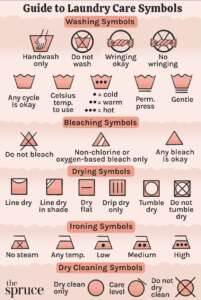In life, some things swirl in an organized cycle of cause and effect, while others just happen with no apparent explanation. Laundry doesn’t seem to be exempt from the games of chance. After all the efforts to systematize the process, washing is still full of surprises. Inexplicable tinting of garments, items coming out of the washing machine five sizes smaller… What is the source of these sorceries? If only there were some sort of key to reveal the secrets of this ancient practice. A guide to break the spell and release our clothes from the curse of misfortune…
Wait, there is something! The legend goes that a little piece of cloth hangs loose from every garment. Those who have seen it, claim that it holds the answers to all the mysteries of laundry. In this article, we will decipher the cryptic symbols that reveal the door to a flawless washing.
International laundry care symbols
Clothes, linen, towels and other items have labels with laundry care instructions. Manufacturers are responsible for ensuring that the labels are permanently attached, fastened and legible during the product’s lifespan. Following these when you visit a laundromat around me means each fabric will receive the best treatment and thus promote durability, brightness and softness. You can find some variations around the world, but there is a general consensus on the use of certain symbols for washing, drying and ironing different fibers.
These are the basic symbols recognized worldwide:
The Federal Trade Commission has determined that the instructions in the labels of products in the US must come in the following order:
- Washing method: machine wash, hand wash or dry clean. This also advises whether wringing can harm the item or not.
- Washing temperature: represented with dots. A single dot means cold water, and the more dots you see, the hotter the water should be.
- Washing cycle: represented with lines. No lines means a normal wash cycle is advised, one line means permanent press and two lines represent a delicate cycle. The more lines under the washtub icon, the more careful you should be with your garment.
- Bleaching instructions: represented with a triangle. An empty triangle means that any kind of bleach is fine, two lines recommend non-chlorine methods and an ‘X’ suggests to keep your item away from any bleach.
- Drying method: represented with a square. Just as in the washing instructions, here you’ll see dots and lines under the square to advise drying temperature and cycle. A circle inside the square means tumble dry is ok, and unless it’s crossed with an ‘X’. No circle suggests air dry, and the lines inside explain the various air-drying methods (lay flat, hang to drip, line dry or shade only).
- Ironing, including temperature and whether steam is suggested. The symbol looks like an iron, and the dots once again represent the temperature. The three dotted lines under the iron advise that it’s safe to steam the garment, unless it’s crossed with an ‘X’.
- Warnings about additional factors that may damage the item. For example, a circle recommends dry cleaning, but if it’s crossed with an ‘X’ it means dry cleaning isn’t good for your item.
Now, we will share a guide (courtesy of Whirlpool) that shows some examples and combinations of what we have just explained. We strongly advise you to study this simple manual to become a laundry expert and protect your favorite fabrics. All you have to do next is come to our laundromat near Rochester Hills, MI and trust that we’ll care for your clothes as carefully as you.

